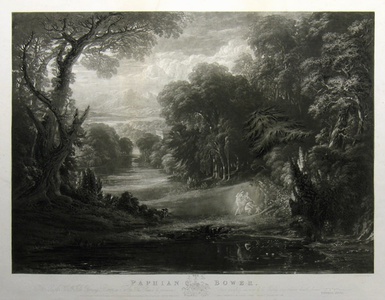| Method | Mezzotint with ethcing |
| Artist | George Henry Phillips after John Martin |
| Published | London, Republished Feby. 15, 1853, by Thomas Boys, (of the late firm of Moon, Boys & Graves) Printseller to the Royal Family, 467, Oxford Street. Paris, E. Gambart & Co. 15, Rue Charlot,_Depose. Originally Published Decr. 1, 1826. |
| Dimensions | Image 585 x 416 mm, Plate 653 x 485 mm |
| Notes |
John Martin's The Paphian Bower depicts three nymphs in the act of pursuing Cupid on a bank of roses. A classical temple is partially obscured by the sylvan landscape, and mountains rise in the distance. In 1822, G.H. Phillips was contracted to engrave Martin's painting of Pan and Syrinx in mezzotint, but before the exhibition, Martin altered the composition by introducing the three Graces and the infant Cupid over the original figures and retitling the work The Paphian Bower. Given the flexibility of mezzotint, Phillips changed the plate accordingly. This print is a version of the final state from the re-worked plate, and the etched hair of Syrinx can be seen floating above the figures. The print was enduringly successful and attracted a number of imitators. In fact, the American painter Thomas Cole went so far as to exhibit a copy of the print alongside his painting of the Garden of Eden in 1828 in order to refute accusations of plagiarism. George Henry Phillips (1800-1852) was a painter, miniaturist, and mezzotint engraver. Talented in his field, Phillips reproduced a multiplicity of subjects including portraiture, genre scenes and landscape. He came to prominence in London between the years of 1819 and 1825, during which time he collaborated with J.M.W Turner for The Rivers of England. Phillips would forge other notable alliances throughout his career; Thomas Lawrence and John Martin to name but a few. John Martin (1789-1854) was an English painter, illustrator and mezzotint engraver. He achieved huge popular acclaim with his historical landscape paintings which featured melodramatic scenes of apocalyptic events taken from the Bible and other mythological sources. Influenced by the work of J.M.W. Turner (1775-1851) as well as Theodore Gericault (1791–1824), Eugene Delacroix (1798–1863) and Paul Delaroche (1797–1856), his paintings are characterised by dramatic lighting and vast architectural settings. Most of his pictures were reproduced in the form of engravings, and book engravings, from which he derived his fortune. Despite his popularity, Martin's work was spurned by the critics, notably John Ruskin, and he was not elected to the Royal Academy. His fame declined rapidly after his death, although three of his best known works of religious art toured Britain and America in the 1870s: The Great Day of his Wrath (1853, Tate, London), The Last Judgment (1853, Tate) and The Plains of Heaven (1851-3, Tate). A great contributor to English landscape painting, Martin was a key influence on Thomas Cole (1801-48), one of the founding members of the Hudson River School. Ex. Col.: Hon. Christopher Lennox-Boyd John Martin-Apocalypse , Tate, 2011, 27. Campbell, Visionary Printmaker, p.188. Inscription content: Contains a dedication to the Right Honourable John Fleming, Baron de Tabley. Condition: Slight foxing to the sheet. Image unaffected. The impression is worn and the etching shows through in areas. |
| Framing | mounted |
| Price | £800.00 |
| Stock ID | 28598 |

